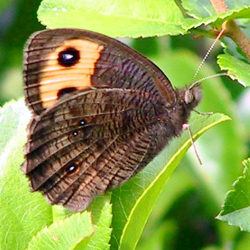Butterfly Atlas
Find a Butterfly
Common Wood Nymph
Cercyonis pegala
Named
Fabricius, 1775

Taxonomy & Nomenclature
Massachusetts is in the zone of intergradation between two subspecies (some authorities say "forms") of Common Wood Nymph with C.p. nephele prevailing to the North and C.p.alope predominating from Massachusetts south. Variability in the zone of intergradation is analagous to that of the distinctive subspecies of White Admiral/Red-spotted Purple.
Identification
Wingspan: 2 - 2 7/8". In New England the great majority of Common Wood Nymphs are easily distinguished from all other species by the large tawny yellow forewing patch standing out against generally dark brown wings and punctuated by two prominent eye spots. The subspecies nephele, which occurs in the mountains and northern areas of the region, lacks the yellow patch and might be confused with the Little Wood Satyr. However the latter is much smaller and has two pale highlights in each of the black forewing eye spots rather than the single bluish highlight characteristic of the wood nymph.
Variations in color, size and shape of the forewing patch and the size and number of eye spots in this species are likely to convince the novice lepidopterist that several confusing species are involved, a perception that many of the early guides reinforced with elaborate taxonomic distinctions. More experience will prove that every conceivable intergradation occurs and that the phenomena should be regarded with interest and aesthetic pleasure rather than frustration.
Distribution
Continent-wide from southern British Columbia and central California east to Nova Scotia and Florida (absent from the southern end of the peninsula). Common throughout New England. Scudder (1889) asserts that the distributional limits of the dark northern and mountain subspecies nephele and the more widespread (in New England) alope meet between the 45 degree and 50 degree annual isotherm. Nephele reaches the southern limit of its New England range in the highlands of northwestern Massachusetts and is the predominant form in northern Vermont and New Hampshire and interior and northern Maine.
Status in Massachusetts
Abundant in its season throughout the mainland and islands. Maximum: 700, 12 July 1993, Plainville (Norfolk Co.). In some years it is sometimes possible to see hundreds flying over coastal salt marshes in July and August.

Flight Period in Massachusetts
Typically early July to early September. Extreme dates: 4 June 1989, Andover (Essex Co.), S. Goldstein; 3 October 1995, Norwood (Norfolk Co.), B. Cassie et al. Scudder (1889) records egg laying on Nantucket on 10 September.
Larval Food Plants
Apparently a wide variety of grasses, though few specific host species have been recorded. Known to eat species of Andropogon (Schizachyrium) and Purpletop (Triodia flava) in the wild and the ubiquitous lawn and pasture species, Kentucky Blue Grass (Poa pratensis) in captivity. Its abundance in coastal salt marshes suggests that Cord Grass (Spartina patens) is another likely host.
Adult Food sources
Male Common Wood Nymphs have rarely been recorded taking food of any kind, and the feeding habits of females appear to be variable and eclectic. Edwards (in Scudder, 1889) says that "multitudes gather on the flowers of the hardhack (Steeplebush) Spirea tomentosa..." and Atlas observers found them on 18 plant species. This butterfly also sips juices of rotting fruits and fungi.

Habitat
Despite its name the Common Wood Nymph prefers open areas including fields, wet meadows, salt marshes, and bogs. It also inhabits open woods and ventures along well lit woodland trails. Scudder‘s picturesque account of disturbing a large roost of wood nymphs in a pine stand at the edge of the Nantucket moors suggests that the species typically retreats from fields to nearby woods or shrublands to roost for the night.
Life Cycle
EGG: Barrel-shaped, ribbed, waxy yellow to pale pinkish. OVIPOSITION: On or near the host grass. LARVA: Green with four paler (whitish or yellow) lengthwise stripes and a red forked tip to the abdomen; it is covered with a short pile of pale hairs. Scudder (1889) describes the caterpillar as "exceedingly lethargic...(moving) by almost imperceptible, nervous, forward twitches. CHRYSALIS: Green and smoothly contoured with pale white or yellow stripes and bands; suspended from grass leaves. PUPAL STAGE: Duration:"... about a fortnight" (Scudder, 1889). OVERWINTERING STAGE: The first instar larva hatches at the very end of the season (often close to the first frost), climbs down to the base of the food plant and hibernates there.
Scott (1986) describes mating in this species as follows: "...the male pursues the female, who lands... and then remains motionless with her wings closed; the male then lands and flutters his wings at full stroke while butting her head with his head (his forewings drawn forward to transfer pheromone from his upper forewing (scent) patch; next he moves to her side and flutters his partly opened wings with smaller strokes, and then bends his abdomen to mate." Males live only two to three weeks while females may live several months, a circumstance apparently related to their tendency to lay their eggs as late in the season as possible.
Account Author
Chris Leahy



